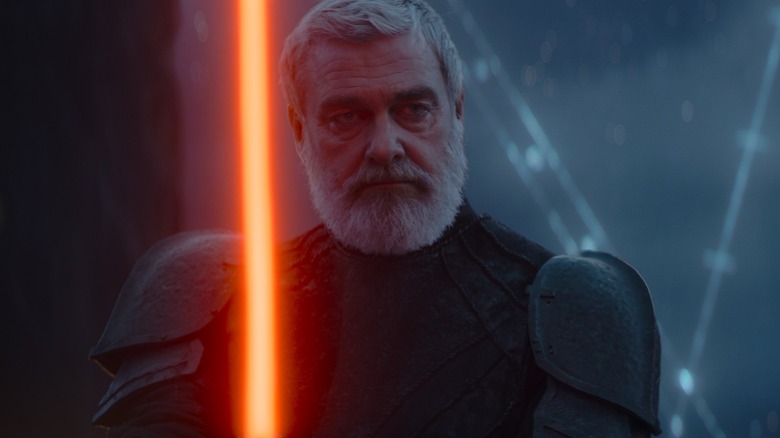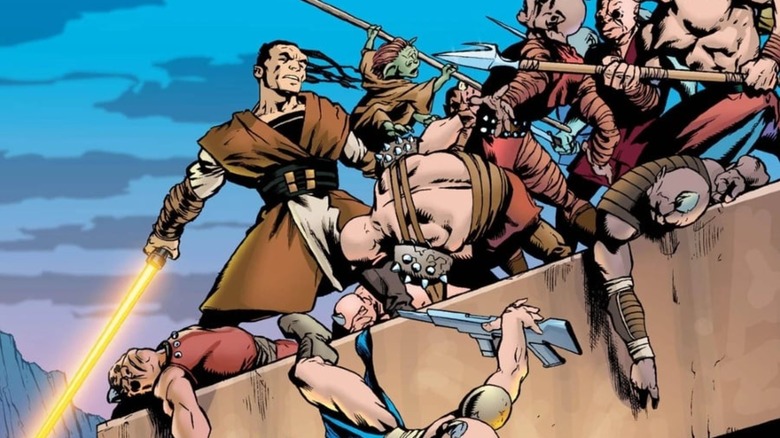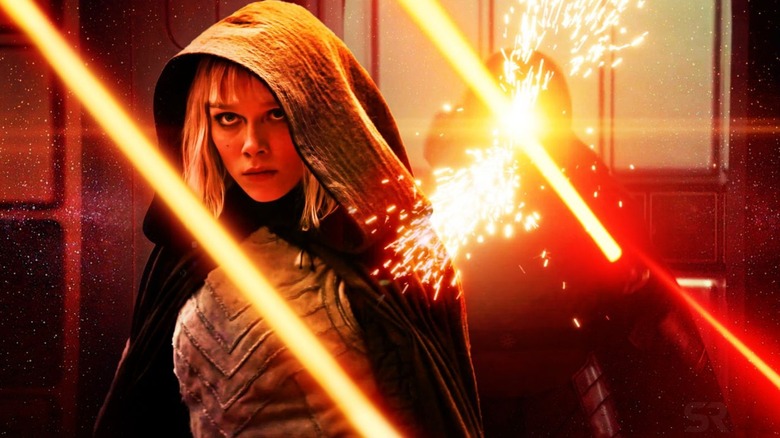Star Wars: The Meaning Of An Orange Lightsaber Explained
When George Lucas introduced the world to "Star Wars" in 1977, there were only two lightsaber colors: red and blue. The former was reserved for the bad guys, while the heroes wielded the latter, and that remained true until "Return of the Jedi." In that film, Luke Skywalker (Mark Hamill) carries a new saber to replace the one he lost, introducing green blades to the franchise. As "Star Wars" expanded into comics, books, video games, and more, additional colors were introduced, each with its own meaning.
That all changed when Disney purchased Lucasfilm in 2012, relegating much of the expanded universe to "Star Wars" Legends. What remained was canon, and the colors of lightsabers and their meanings changed as well. While black remains the rarest "Star Wars'" lightsaber color, one hue that's also remained largely elusive both in Legends and subsequently in canon is orange.
Force-users who prefer orange lightsabers are few in the franchise, and for those unfamiliar with Legends material, they likely didn't realize they existed until "Star Wars: Ahsoka" debuted on Disney+. In that series, two Force users carry orange-red sabers, which showrunner Dave Filoni purposefully chose to set Shin Hati (Ivanna Sakhno) and Baylan Skoll (Ray Stevenson) apart. He picked orange so that viewers wouldn't immediately know the characters' allegiances to the Force. Lightsaber rules within the franchise don't always make sense, but the colors are still fairly easy to understand.
The meaning of orange lightsabers in Legends
In the years before Disney's acquisition of the "Star Wars" franchise, orange sabers found their way into the hands of Jedi introduced in the Prequel Trilogy. Master Plo Kloon wielded an orange lightsaber during the Stark Hyperspace War prior to the Clone Wars. Master Yaddle also carried an orange blade, though by the time they sparked theirs in canon, the colors had changed to blue and green, respectively. For a time, Darth Bane carried an orange lightsaber, so the color wasn't just limited to Jedi.
Polvin Kut was a Jedi who lived two centuries before the outbreak of the Clone Wars. He carried an orange blade and was master to Yaddle, with all these comic book appearances stemming from Dark Horse Comics' various "Star Wars" series. After the Disney takeover, Dark Horse's books all became part of Legends, though some elements transitioned into canon. That said, the colors of the aforementioned lightsabers did not.
Legends often associated orange blades with so-called Gray Jedi, Force-sensitive people who didn't adhere to either the light or dark sides of the Force, but the concept of Gray Jedi is not currently included in canon. Other orange blades in Legends belonged to the Sentinel class, charged with protecting the Jedi Temples. In canon, these were replaced with yellow blades.
Star Wars canon classifies lightsaber colors differently
The first canon appearance of orange lightsabers comes in the 2019 video game "Star Wars Jedi: Fallen Order," where Cal Kestis wields one. There is no attributable meaning to it, and the game allows the player to change it to any color they prefer. The 2023 sequel, "Star Wars Jedi: Survivor," continued this trend, while a more detailed introduction of lightsaber colors in canon arrived in 2024's "Star Wars: The Acolyte," which shows a rainbow of blades wielded by various Jedi.
Unfortunately, none were orange, despite making their live-action debut in "Star Wars: Ahsoka." While there's no clarification in that series' narrative as to why the blades of Shin Hati and Baylan Skoll are orange-red, Dave Filoni's explanation makes sense: He saw Darth Vader's red blade as flickering somewhat towards orange, and wanted to bring that color out in the sabers of his two Force-wielding mercenaries. While they're more orange than red, you can see red accents in the blade's edge, producing a darker orange than those seen in Legends.
Despite Filoni's remarks, there's no depicted canon explanation for the lightsaber color's meaning. This is somewhat true of all canon, as there's no elucidation for why Mace Windu's (Samuel L. Jackson) lightsaber is purple in the films (ultimately, it was because of the actor's preference). Color explanations primarily come from supporting materials and sourcebooks that explain their meaning. For orange, the color represents a middle path, independence, and an ethical pragmatism.


